WARHOLSTARS 1963
1928 - 1959 - 1960 -1962 - 1963 - Jan - May 1964 - June-December 1964 - 1965 - 1966 - 1967 - 1968 -1969 - 1970 - 1974 - 1975 - 1979 - 1980s+
1963: ANDY WARHOL WORKS FROM HIS FIRST STUDIO OUTSIDE HIS HOME.
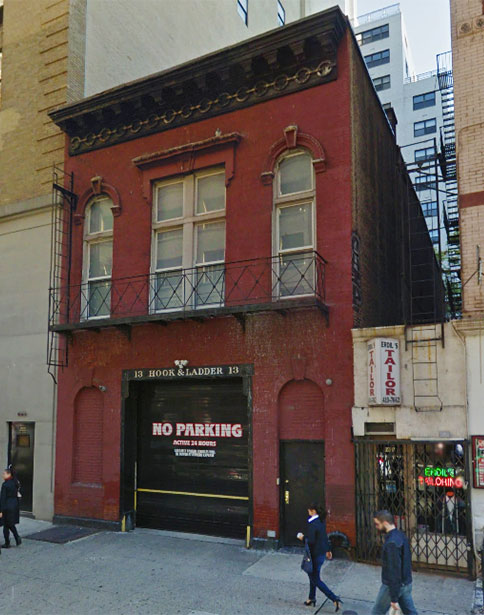
Andy Warhol's first studio outside his home, c. 2016
From the Andy Warhol Catalogue Raisonné:
"Between 1961 and 1962, Warhol's studio was in his house at 1342 Lexington Avenue. During 1963, he worked on the second floor of an abandoned building that he leased from the city - the 13th Hook and Ladder Company, which was located on East 87th Street, near his house." (RN468)
It is unknown exactly when Warhol moved into the building but, as pointed out in the catalogue raisonné, "In a letter to the Department of Real Estate, dated November 19, 1962, Warhol offered to pay $150 month to rent an 'obsolete fire house' on East Eighty-seventh Street. This was to become Warhol's next studio although in mid-December [1962] when he was included in the CBS documentary Exhibition: Contemporary American Painters... he still may be seen working at 1342 Lexington Avenue. While working at the Firehouse Warhol "usually brought his paintings to 1342 Lexington, where they were stored rolled, or shown unstretched to visitors; visitors to the Firehouse were exceptional... until the Factory period, Warhol continued to show his work and receive friends at home." (RN468)
In Popism, Pat Hackett, writing as Andy Warhol, says "by the beginning of '63 my [Warhol's] work area at home was a total mess... A friend named Don Schrader had come across an old firehouse on East 87th Street, a hook and ladder company that some guy had leased from the City of New York for about a hundred dollars a year, and the guy offered to sublet part of it to me. As soon as I moved my stuff over there, I began to look around for an assistant." (POP25)
The assistant he eventually ended up hiring was Gerard Malanga. Gerard recalls that he was first introduced to Warhol in 1962 but did not start working for him until June 11, 1963.
Gerard Malanga:
"I was introduced to Andy Warhol in the Fall, 1962, at a party given by the underground filmmakers, Willard Maas and Marie Menken... Several months later, June 9, 1963, to be exact, Charles Henri Ford was aware that Andy was in desperate need of an assistant... On June 11, I began working for Andy at what was then his studio, a condemned hook & ladder company located on 87th Street between Lexington and Third Avenues..." (GMW139)
WINTER 1963: ANDY WARHOL TAKES "SPEED."
Warhol got a prescription for pharmaceutical "speed" (Obetrol) from his doctor after seeing a picture of himself in a magazine in which he thought he looked fat.
Andy Warhol (via Pat Hackett in Popism):
"Since there were usually as many as forty people out in Old Lyme every weekend, there were never enough beds; but most of the guests didn't sleep anyway. I was awake a lot myself - I'd started taking a fourth of a diet pill a day (Obetrol) that winter after I saw a picture of myself in a magazine where I looked really fat... And now, because I was awake so much, I started having more time on my hands." (POP33)
Warhol's comments (as filtered through Pat Hackett) suggest that he started taking Obetrol ("speed") during the winter before the weekend in Old Lyme - during the winter of '62-63 rather than '63-'64. According to Warhol biographer Victor Bockris, Warhol also took Seconal in order to counteract the "speed" and allow himself to sleep. (L&D224) According to Bockris, Andy took Obetrol until late 1968 when he was forced to stop while recuperating from his bullet wounds. (L&D312) Warhol then started taking Dexamyl - a combination of amphetamine and barbiturate. (BC117)
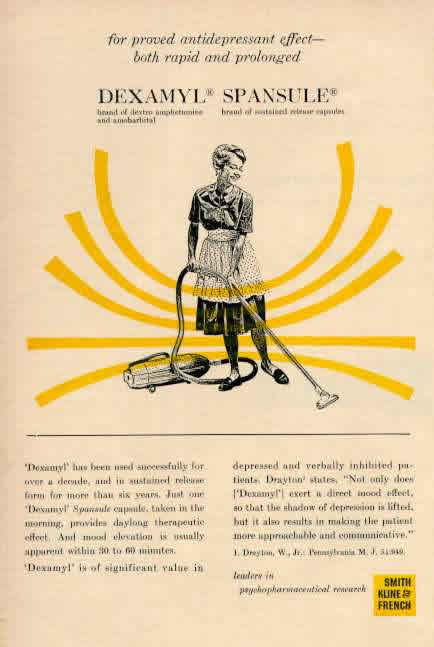
An advert for for the sustained release "spansule" of Dexamyl which lasted all day
Brigid Berlin later told Bob Colacello that Andy took one or two Obetrols every day until he died. (BC50). Warhol told Bob Colacello in June 1972, during a trip to Mexico, that he took Dexamyl on a regular basis:
Andy to Bob Colacello: "It's just so hard to get up in the morning. It would be so much easier to stay in bed all day, wouldn't it? I have to take, uh, a pill to get going. I just don't have any energy since I was shot."
Bob Colacello: "What kind of pill?"
Andy Warhol: "Oh, uh, just a little Dexamyl. It's nothing." (BC117)
EARLY 1963: ANDY WARHOL DOES EARLY SERIAL DISASTERS INCLUDING ELECTRIC CHAIR PAINTINGS.

Andy Warhol painted his Electric Chair paintings from a photograph rather than from an actual chair. The source was a photo distributed by World Wide Photo, dated January 13, 1953, captioned "This is a view of the death chamber and electric chair in Sing Sing Prison at Ossining, NY, in which convicted atom spies Julius and Ethel Rosenberg are slated to be electrocuted." (RN311)
From the Andy Warhol Catalogue Raisonné (Vol. 1):
"In an interview with Gene Swenson, Warhol associated the beginnings of his 'death' series with statistics he heard projecting holiday traffic fatalities in late 1962... Around Labour Day 1962, Warhol was probably still at work on the Marilyn paintings, a series also related in his mind to death. In mid-December, he was documented screening a Suicide painting... Thus it seems reasonable to propose that his first paintings based on car-crash subjects originated about this time. A loan receipt for an electric chair painting, Silver Disaster #6 (cat. no. 362), from the Guggenheim Museum, dated late February 1963 established the first terminus ad quem for a death-themed painting that year... Only six known works with the 'Disaster' in their titles are numbered: Green Disaster #2 (cat. no. 343); Black and White Disaster #4 (cat. no. 346); Orange Disaster #5 (cat. no. 356); Silver Disaster #6 (cat. no. 362); White Disaster #40 (cat. no. 346); and White Disaster #41 (cat. no. 427)... Disasters #2 and #4 are both serial car crashes... Disaster #5 and #6 are electric chair paintings, and Disasters #40 and #41 are examples of the Burning Car Crash series (cat. nos. 425-28), made later in 1963. It is not likely that the numbers would have been assigned by Warhol in the studio; more likely, they were given by the Stable Gallery as works were consigned or loaned to exhibitions." (RN310)
The cat. rais. has attributed the earliest of the above numbered Disasters to January-February 1963.
[Note: There are problems regarding the authenticity of the oft-quoted Swenson interview. Warhol's responses to Swenson's questions often do not sound like Warhol, For instance, Swenson asks Warhol "Is Pop a bad name?" Warhol apparently responds, "The name sounds so awful. Dada must have something to do with Pop - its so funny the names are really synonyms. Does anyone know what they're supposed to mean or have to do with, those names? Johns and Rauschenberg - Neo-Dada for for all these years, and everyone calling them derivative and unable to transform the things they use - are now called progenitors of Pop. It's funny the way things change. I think John Cage has been very influential, and Merce Cunningham, too, maybe. Did you see that article in the Hudson Review? It was about Cage and that whole crowd, but with a lot of big words like radical empiricism and teleology." Warhol was not known to use terms like "derivative" and "progenitors of Pop," even when quoting others. According to Warhol biographer, David Bourdon, "This widely quoted interview is troublesome for art historians. Swenson and Warhol were good friends, but the artist was in one of his uncooperative moods, prompting the critic to conceal his tape recorder during the interview. Some of the more 'intellectual' sounding quotes attributed to Warhol may have been doctored by Swenson, particularly the remarks concerning the Hudson Review, a literary quarterly that Warhol was not known to read." gc.]
1963: ANDY WARHOL PAINTS MONA LISA.
Nan Rosenthal:
"The ubiquity of the grid in post-Cubist painting has been discussed often. Warhol may have hit upon grids anywhere - in the work of Rauschenberg and Johns which he so admired or in photography, for example, Walker Evans' famous Photographer's Window Display, 1936... What I wish to show is how clever a designer Warhol could be with composition and with colour to signify an idea even with something as basic - as obvious - as a grid. This is apparent if we look at his ten-foot-tall Mona Lisa, which I believe to be one of Warhol's finest paintings. The occasion for his making this 1963 work and related, smaller Mona Lisas, of which there are at least three, was when André Malraux, then the French minister of culture, agreed to request of the Kennedy White House and the National Gallery of Art to lend the Leonardo from the Louvre to the National Gallery in Washington and the Metropolitan Museum in New York. This produced an immense amount of attention from the mass media and long lines outside both institutions." (NR46)
Leonardo da Vinci's Mona Lisa was exhibited at the National Gallery of Art in Washington, D.C. from 8 January to 3 February 1963 and at the Metropolitan Museum of Art in New York from 7 February to 4 March, 1963.Although the Andy Warhol Catalogue Raisonné notes the painting's "topical celebrity" at the time "as evidenced in magazines such as Time (Dec. 24, 1962)..." (RN293) However, there is no December 24th issue of Time magazine on the Time.com site. However, the arrival of the painting was noted in the December 21st issue of Time (a weekly magazine):
From "People" (Time, 21 December 1962):
"Sentries stood 24-hour guard at her cabin door on the S.S. France. She was tied to a berth and encased in an airtight 160-lb. plastic container impervious to salt and water. No one would insure her against harm because she is priceless. But a warm welcome awaits the Mona Lisa on her arrival this week at Washington's National Gallery. Officials are fiddling with the thermostats to duplicate the Louvre's temperature and humidity so that all will be well on Jan. 8 when the painting goes on display for three weeks. Back home, the rhubarb over her visit to the U.S. raged all the louder. "Knowing Americans," snarled one art critic 'they'll probably have her parading down Fifth Avenue in the bitter cold in an open car under tons of confetti.'"
Life magazine ran a large article about Leonardo's painting in the U.S. in their January 4, 1963 issue which can be found here and Art News also ran an article about the Mona Lisa in their January 1963 issue. (RN293)
1963: LOU REED INJECTS HEROIN.
Lou started injecting heroin while still a student at Syracuse University. (LR68)
1963: ANDY WARHOL DESIGNS AN ALBUM COVER.
In addition to his commercial illustrations in magazines Warhol had designed various album covers. This particular recording was made by Billy Klüver of interviews with pop artists.
The cover resembled a supermarket ad with "GIANT SIZE $1.57 EACH" in bold black lettering. The record accompanied The Popular Image exhibition at the Washington Gallery of Modern Art. The edition of seventy-five numbered record covers are considered fine-art prints today rather than mass-produced record covers. (AWM65)
Klüver was was a staff scientist at Bell Telephone Laboratories in Murray Hill, N.J., from 1958 to 1968. He was particularly interested in the relationship of art to technology. He was one of the founding members of Experiments in Art and Technology (E.A.T.) which earned him a Chevalier des Arts et des Lettres from France and the Royal Order of Vasa from Sweden.
When Warhol later created his Silver Clouds, he asked Klüver to come up with a way of making them float. Klüver died on January 11. 2004.
JANUARY 29/30, 1963: BILLY NAME DOES LIGHTS FOR JUDSON DANCE CONCERTS #3 and #4 FEATURING FRED HERKO AND YVONNE RAINER.
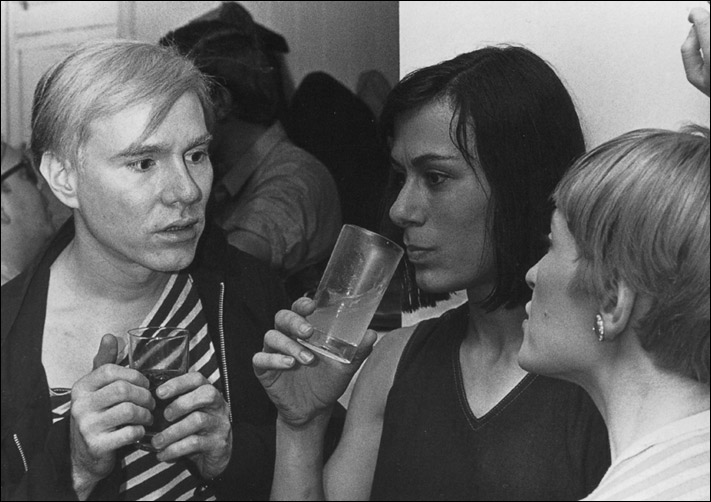
Andy Warhol, Yvonne Rainer (center) and Barbara Rose at a party at Henry Geldzahler's apartment, NYC, spring 1965 (Photo: David McCabe)
BILLY NAME (as Billy Linich) did the lights for Concerts of Dance #3 and #4 for the Judson Dance Theater group. Among the dancers were Warhol stars FRED HERKO, LUCINDA CHILDS and YVONNE RAINER. (JD83/85) (The first performance by the dance group had taken place on July 6, 1962 at the church.)
Herko performed a solo dance Little Gym Dance Before the Wall for Dorothy on the 29th and and Lucinda Childs performed a solo on the 30th - Pastime. (JD85)
The dance concerts were reviewed by Jill Johnston in the Village Voice. The performances made dance out of ordinary human movements, such as running, walking or waiting, performed by experienced dancers as well as "non-dancers," just as Warhol would film ordinary movements in films like Eat or Sleep (albeit adding an element of repetition - in both Eat and Sleep, Warhol repeated footage rather than just filming an event as it took place.) The Judson Dance Theater used "non-dancers." Andy Warhol used non-actors. The Judson dances were largely "plotless" as were Warhol's early films. Some of the people who became part of Warhol's coterie worked with the Judson dancers, including Billy Name and Fred Herko.
Jill Johnston ("Dance: Judson Concerts #3, #4," The Village Voice, February 28, 1963, p. 9, 19):
"Yvonne Rainer opened the first program with a running dance (We Shall Run, to the Berlioz Requiem) performed by twelve dancers and non-dancers... No plots or pretensions. People running. Hurray for people.
Miss Rainer also repeated Three Seascapes. And she danced in many other pieces, including Steve Paxton's Words Words. Aside from her extraordinary presence and technical command, Miss Rainer is the most independent chorographer of this particular scene. To be more general about it, I think she's the greatest thing since Isadora cross the Atlantic...
Mr. Paxton also danced with Judith Dunn in her duet Index, to music of intermittent mouth sounds composed by Robert Dunn... [An] interesting episode was a jagged success of tense pretended balances followed by lunges of one at the other around the neck to make both collapse, and crash on the floor.
This sequence reminds me a little of Trisha Brown's duet, Lightfall, also performed with Steve Paxton. Using the simple action of waiting (football style, hands on knees) as a recurrent 'base,' the dancers initiated a spontaneous series of interferences - ass-bumbing and backhopping - which were artless playful excursions in quiet expectancy and unusual surprises. Miss Brown has a genius for improvisation...
Another long duet was William Davis's Field, performed Barbara Lloyd, accompanied by transistor radios... attached to their waists...
Elaine Summers' Suite is funny and well-timed, much better than the Woodstock version. Ruth Emerson's Giraffe is expansive, extended, east, controlled. Lucinda Childs' Pastime is an intense, cryptic solo of three episodes... Deborah Hay's City Dance for group is an imaginative abstract of hurried motion... Carol Scothorn's The Lazarite communicated the idea that 'there is no death.'
Fred Herko's Little Gym Dance Before the Wall for Dorothy is a wonderful vignette: coming in straight out down the middle, removing jacket and boots, and sauntering off casually straight out down the middle. And Arlene Rothlein - she was a sweet breath of spiced lilacs in her solo It Seemed to Me There was Dust in the Garden and Grass in My Room.
... Additional attractions on both programs were Carolee Schneeman's mad orgy Newspaper-Event; Bob Huot and Bob Morris dressed (smothered) in the most incredible gorgeous panoply and trying to kill each other for real in War (La Monte Young beating a steady, resounding gong) and an amazing musical event, Certain Distilling Processes, by Philip Corner, employing four dancers as conductors and seventeen intriguing persons making noise with instruments of many descriptions."
Sally Banes drew an analogy between Pop and the Judson dance group in her book Democracy's Body: Judson Dance Theatre, 1962 - 1964).
From Democracy's Body: Judson Dance Theatre, 1962-1964 by Sally Banes:
"Nondance movement was called into service as material for a dance... Like Pop artists, the Judson choreographers were fascinated by the everyday and put mundane objects and activities in their dances in ways that "made them strange," as the Russian Formalist critics had described in literature. A newspaper used as clothing or as something to shred and play in; a radio blaring banally as the background for a romantic pas de deux; references to football and other athletics, to social dancing, to daily activities - all these elements were a way of making the viewer stop to examine more closely the things one ordinarily takes for granted... Rather than an image, a story, an atmosphere, or a phrase, the various choreographic strategies (repetition, improvisation, task instructions, 'one thing,' frozen moments) foregrounded the movements, the smallest possible segment of dance work." (JD106-7)
APRIL 1963: ANDY WARHOL PAINTS TUNAFISH DISASTERS.
From the Andy Warhol Catalogue Raisonné (Vol. 1):
"Warhol used a page from Newsweek dated April 1, 1963, as the basis for his series of paintings about a can of contaminated tunafish that killed two housewives in a suburb of Detroit... Where the date of the Newsweek article marks a terminus a quo for the series, a terminus ad quem in early May is established by a dated slide taken by Ellen Johnson that shows Warhol stretching a Tunafish canvas at the Firehouse with an otherwise unknown studio assistant identified only as Max... April 1963 is consequently proposed as the date for the series... The title Tunafish Disaster seems to have been cited first by [Rainer] Crone. The paintings were not widely known or published during the 1960s, and Crone recorded only four..." (RN342)
c. SPRING 1963: ANDY WARHOL DOES PHOTOBOOTH PICTURES FOR HARPER'S BAZAAR - LEADING TO ETHEL SCULL COMMISSION.
From the Andy Warhol Catalogue Raisonné (Vol. 1):
"In the June 1963 issue of Harper's Bazaar, a feature titled 'New Faces, New Forces, New Names in the Arts' was illustrated by a layout of photographic portraits made in automated photobooth machines... Gerard Malanga recalled the project and identified it as probably the first time that Warhol used 'photomat' pictures. According to Ruth Ansel who gave Warhol the assignment, I gave him the list of names, the people to be photographed, and he took them to some photomat machines... and came back with a series of portraits: out of focus, front, side, feet showing, heads cut off, everything wrong, and everything right because of it. I loved them and put them down on the page in the most honest way I could: not cropping, not making them look better, and certainly no retouching.' While the magazine staff selected the subjects, they also included people that Warhol knew, such as Rosalyn Drexler and Henry Geldzahler, as well as Warhol himself. The work that ensued directly from the commission was the portrait of Ethel Scull... Warhol also used photobooth pictures to produce commissioned portraits of himself... and Judith Green... as well as portraits of Bobby Short... which were not commissioned." (RN409)
As Warhol's photobooth pictures were featured in the June 1963 issue of Harper's Bazaar, they would have been done earlier, during the spring, because of the magazine's copy deadline - before Gerard Malanga started working for Warhol.
APRIL 28 & 29, 1963: YVONNE RAINER PERFORMS SLEEP AS PART OF HER DANCE PIECE TERRAIN AT THE JUDSON DANCE THEATER. (RO220/JD115)
Yvonne Rainer's Terrain, was referred to in Popism as the first "Judson Church 'happening'" that Warhol 'guessed' that he attended. Robert Rauschenberg did the lighting and flyer for the event. (JD112)
Andy Warhol (via Pat Hackett) in Popism: The Warhol Sixties
:
"I guess I went down to my first Judson Church 'happening' because of Rauschenberg - he was arranging the lighting there and I wanted to see it. I called up David Bourdon and told him to come with me to this beautiful concert there by Yvonne Rainer called Terrain, and later David said it was the most modern dance thing he'd ever been to." (POP51)
Rainer's dance was based around ordinary movements like walking, running or crawling. The last dance of the "Solo Section" of the performance was "Sleep" - performed by Yvonne Rainer, Albert Reid and Trisha Brown. (JD115) About a month after seeing Rainer's performance, Warhol asked his then boyfriend, the poet JOHN GIORNO, if Giorno would mind if Warhol filmed him sleeping. The result was Warhol's first film, also called SLEEP.
APRIL 18 - JUNE 2, 1963: THE POPULAR IMAGE AT THE WASHINGTON GALLERY OF MODERN ART.
"The Popular Image" exhibition included work by Andy Warhol, Jim Dine, George Brecht, Jasper Johns, Roy Lichtenstein, John Wesley, Robert Watts, Tom Wesselmann, Claes Oldenburg, Jim Rosenquist and Robert Rauschenberg.
A Pop Art Festival was organized by Alice Denney in conjunction with the exhibition which included a lecture-concert by John Cage on the night of the show's opening, two Happenings by Claes Oldenburg and Concert of Dance (#5) by the Judson Dance Theater.

Robert Rauschenberg in Pelican during a 1965 performance at the First New York Theater Rally (first performed at the Pop Art Festival in 1963)
(Photo: Peter Moore) (RA124)
See "Robert Rauschenberg, Pelican and the Judson Dance Theater."
Rollerskates were popular in the "underground" dance scene in 1963. Fred Herko performed on a rollerskate in the Judson Dance Concert #6 (see below) and Warhol filmed him c. September 1963 for his film Rollerskate.
The Concert of Dance took place at America on Wheels, a rolling skating rink at Kalorama and Seventeenth Streets in Washington, D.C. on May 9, 1963. (JD120) Robert Rauschenberg choreographed and participated in a dance titled Pelican - performed on roller skates to a collage of music on tape which included marching music by Handel and Haydn and sounds from radio and television. Another dance, Lemon Hearts Dance, was titled after the 1962 experimental film, Lemon Hearts starring Warhol star TAYLOR MEAD. (JD124)
Billed as "an extension" of the concert series at Judson Memorial Church, the evening was organized by Billy Klüver with the help of Robert Dunn. Klüver would later help Warhol create his Silver Clouds (sometimes referred to as Warhol's Silver Pillows).
EARLY MAY AND JUNE-JULY 1963: ANDY WARHOL DOES STUDIO AND FERUS ELVIS PAINTINGS.
From the Andy Warhol Catalogue Raisonné (Vol. 1):
"Warhol made two types of compositions based on the same picture of Elvis Presley. The source has not been located but a comparable image has been identified in the Warhol archive - a colour postcard, printed in Germany, that shows Presley as a gunslinger... On the back, the movie is identified as Flaming Star, a Western directed by Don Siegel. It is also inscribed with the following note, 'Greetings from Paris to Andy Star - Charles Henri [Ford] July 1963.' Other signatures are also scrawled across the back. The postcard, a souvenir that surely postdates paintings Ford had already seen, documents Warhol's source and helps to establish a date before July 1963 for the paintings.
In an interview with John Wilcock in 1971, Ford recalled seeing the paintings and filming Warhol at the Firehouse with actress Jean Seberg. That occasion was also photographed by Duane Michals and published in Glamour in September 1963... Ford remarked that Elvis paintings were 'for a California show,' an exhibition at the Ferus Gallery in Los Angeles that opened on September 30... The Ferus show had been conceived around the Elvis paintings since at least May. Two letters from Irving Blum to Warhol record its progress. In the first, dated May 12, Blum asked how the 'new series' is coming. On May 28, he wrote again, 'the more I have had the opportunity to consider it, the more convinced I am that your exhibition in the gallery should be the most intense and far reaching composite of past work, and the Elvis paintings should be shown in my rear gallery area.' As with the Paris exhibition of his 'death' series, however, Warhol insisted on focusing on his new work, showing the Elvis series in the divided front gallery at Ferus... and a new, silver Liz series in the back.
Between May and September, however, Warhol remade the Elvis series intended for Ferus. In early May, Ellen Johnson had visited Warhol at the Firehouse and photographed him sitting in front of a row of Elvises tacked to the studio wall... The rags and cans of black paint on the studio floor suggest that the Elvis canvas had been completed only recently. Johnson's slide is crucial in dating these works to early May 1963, directly after the Tunafish Disasters... A comparison of the canvas [in Johnson's photograph]... with the paintings exhibited at Ferus reveals that they are different. The works at the Firehouse correspond to paintings that were found in the studio at Warhol's death. The 'studio' Elvises, as they are designated here, are roughly the same height as the canvases shown at Ferus in September... but the screen used for each is different...
Charles Henri Ford recalled that when he introduced Gerard Malanga to Warhol, the latter had 'just lost a helper' and needed an assistant for his silkscreen work... Malanga began working in early June and has recalled that he initially assisted Warhol with a group of 40 by 40 inch Elizabeth Taylor paintings on silver backgrounds, surely the works intended for the back room at the Ferus Gallery... The Elvis paintings for Ferus must have followed not long after in June and July." (RN355)
See also: c. OCTOBER 1962: ANDY WARHOL DOES EARLY ELVIS PAINTINGS .
MAY 9, 1963: JEAN PAUL SARTRE'S NO EXIT AT THE CAFFE CINO
The performance is listed in the May 9, 1963 issue of the Village Voice, playing "through Saturday" and directed by Joe Cino.
MAY 16, 1963: FINAL SCREENING AT CINEMA 16: THE KISS AND WHEN THE CLOUDS ROLL BY.
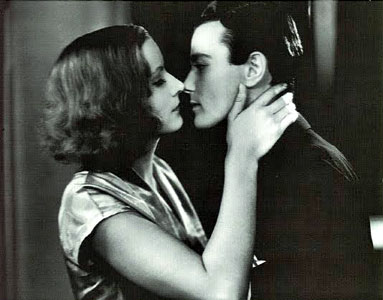
Greta Garbo and Lew Ayres in The Kiss
Amos Vogel's Cinema 16 was a film membership club, incorporated in November 1947, where alternative films were often screened prior to the formation of Jonas Mekas' Filmmakers' Cooperative "cinematheques." Films shown included works by Robert Breer, John Cassavetes, Shirley Clarke, Bruce Conner, Joseph Cornell, Brian DePalmer, Norman McLaren, Jonas Mekas, Sidney Peterson, Roman Polanski, Alain Resnais, Jacques Rivette, Lionel Rogosin, Carlos Saura, Francois Truffaut, Stan Vanderbeek, Melvin Van Peebles and Agnes Varda. (CS8)
When Amos Vogel's wife Marcia, was asked in a 1985 interview to name some of the people who were "particularly strong influences" at Cinema 16, she recalled "Parker Tyler, Hans Richter, Siegfried Kracauer, Marcel Duchamp, Alfred Hitchcock. And, of course Dylan Thomas. Regulars were Maya Deren, Shirley Clarke, Anais Nin, Carmen D'Avino - all the avant-garde artists, painters, filmmakers, people experimenting with synthetic sound, dancers." (CS67)
Cinema 16's final program, as listed in their Program Announcement: Fall 1962/63, was titled "Garbo and Fairbanks: Two Hollywood Myths." The films shown were The Kiss, a silent film starring Greta Garbo and the surreal comedy When The Clouds Roll By with Douglas Fairbanks. (CS410)
Jonas Mekas:
"The Cinema 16 crowd was a very specific group... It was the Madison Avenue world and the fine arts crowd. It was not, I would say, the lower middle classes. But whatever it was exhausted itself after and decade and attendance naturally began falling off. Also, after the Beat generation and their democratisation of the arts, a new, completely different, sloppier audience began developing and going to different places to see films. To them, Cinema 16 was too clean, too official. And of course, around that time avant-garde films began changing on both coasts. With Ron Rice and Robert Frank and others, a sloppier film came in." (CS417)
It is unknown whether Warhol was a member of Cinema 16, however, as a highly successful commercial illustrator (and therefore part of the "Madison Avenue world" that Mekas refers to) he might have attended screenings or would certainly have known about them through Emile de Antonio who was in the process of starting up an alternate film distribution system when he was friends with Warhol. In c. August 1963 Warhol began filming his own Kiss movies which were originally shown at one of Jonas Mekas' venues. The reason usually given for Warhol's Kiss movies is that the idea came from the old Hayes Office regulation forbidding actors in movies from touching lips for more than three seconds.
See c. August 1963:Andy Warhol shoots Kiss.
MAY 1963: ANDY WARHOL'S WORK IS INCLUDED IN PARIS EXHIBITION.
The exhibition, "Pop Art Américain," at the Ileana Sonnabend Gallery, included three paintings by Andy Warhol in addition to work by Lee Bontecou, John Chamberlain, Claes Oldenburg, James Rosenquist and Tom Wesselmann. The Warhol paintings shown in that exhibition were Big Torn Campbell's Soup Can (Black Bean), Marilyn in Black and White and Twenty Marilyns and were part of a consignment dated October 7, 1962 which also included Campbell's Soup Can (Tomato), Green Coca-Cola Bottles and Four Marilyns. (RN473)
MAY - JUNE 1963: ANDY WARHOL PAINTS RACE RIOTS.
From the Andy Warhol Catalogue Raisonné (Vol. 1):
"On May 3-5, 1963, civil rights demonstrators in Birmingham, Alabama, were attacked by police with dogs and high-powered fire hoses. On May 17, three photographs of the demonstrations taken by Charles Moore were reproduced as a double-page spread in Life. Warhol mobilizes the same graphic principles as Life's designers did... Such stylistic devices help to situate the paintings in early 1963. Given the terminus a quo of the publication date of the magazine, May - June 1963 seems a plausible date. It is likely that Warhol conceived of these works in relation to the paintings he was preparing for his show at Sonnabend Gallery in Paris... Catalogue number 421 was included in the Paris exhibition... published as Pink Race Riot. In 1965, the ICA, Philadelphia, published cat. no. 422 [Mustard Race Riot] as Selma, a more neutral if inaccurate title... " (RN380)
Other Race Riot paintings - titled Little Race Riots by Rainer Crone in the 1970 catalogue raisonné - were done in 1964.
MAY 1963: THE "BILLY LINICH SHOW" TAKES PLACE AS PART OF THE YAM FESTIVAL?
Dance writer Sally Banes, mentions the "Billy Linich Show" when writing about the Yam Festival in her book about the Judson Dance Theater. (Billy Linich was, of course, the real name of Factory photography, Billy Name.)
Sally Banes (Democracy's Body: Judson Dance Theater, 1962 - 1964 (London: Duke University Press, 1993), p. 131):
"During the month of May 1963, a number of Fluxus people and other artists put on a Yam Festival (spelling May backwards), which was sponsored by the Smolin Gallery... A number of Judson Dance Theater workshop participants performed in the Yam Festival. 'The Billy Linich Show,' happening throughout the month, included appearances by members of [James] Waring's company."
It's unclear where Banes got her information from as it is not footnoted and Billy Name (Linich) is not listed among her list of interviewees at the end of her book.
A reference is made to the "Billy Linich Show" in issue no. 26 of The Floating Bear, a newsletter founded by Diane di Prima and LeRoi Jones, but that issue was published in October 1963 and guest-edited by Billy Name (see October 1963 below). There is no other mention in that issue of the newsletter of the "Billy Linich Show" although there is an apparent 'quote' by George Brecht about the Yam Festival: "Billy, thanks for the information about THE (must be jelly cause) YAM (don't chic like that) FESTIVAL. George Brecht (io, ed.)" (FB289)
A calendar of Yam Festival events was produced by George Brecht and Robert Watts:

Front page of Yam calendar
The calendar is described in the following way in the Modern + Contemporary Art (catalogue 141) of ars libri ltd (Boston):
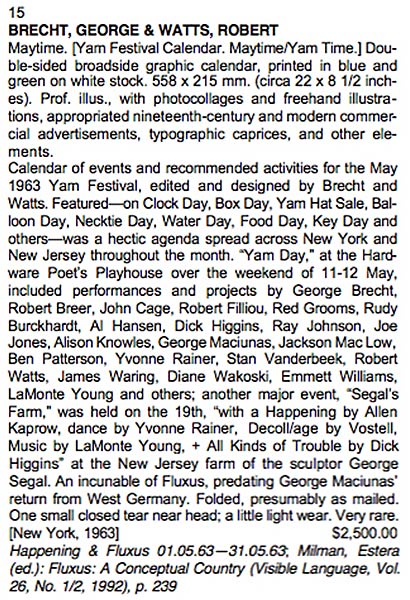
Listing in the ars libri catalogue for the YAM calendar
The events at the Hardware Poets' Playhouse were advertised in May 9, 1963 issue of the Village Voice:
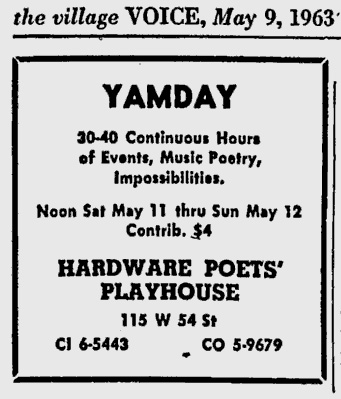
Village Voice ad, May 9, 1963
The "30 - 40 Continuous Hours" of events at the Hardware Poets' Playhouse, as described by Sally Banes, included works by George Brecht, Robert Breer, Earle Brown, John Cage, Philip Corner, Malcolm Goldstein, Red Grooms and Rudy Burckhardt, Al Hansen, Dick Higgins, Spencer Holst, Ray Johnson, Jill Johnston, Brooklyn Joe Jones, Alison Knowles, George Maciunas, Jackson MacLow, Robert Morris, Yvonne Rainer, James Tenney, JAMES WARING, Christian Wolff and La Monte Young. (JD131-2)
The "happening" at George Segal's Farm that was part of the Yam festival, was advertised in the following week's Voice:
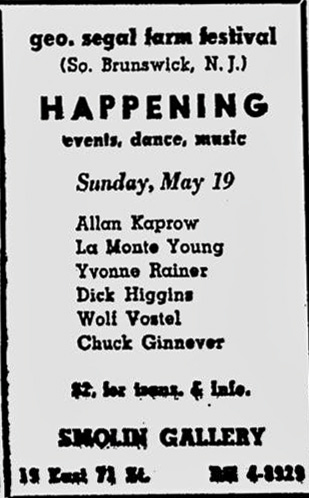
Village Voice ad, May 16, 1963
The events at the farm were reviewed in the May 23, 1963 issue of the Voice:

Village Voice, May 23, 1963 - for full article click here
MAY 27, 1963: TAYLOR MEAD PERFORMS IN BLOSSOMS AT THE SQUARE EAST THEATER ON WEST 4TH STREET.
An article written by Blossom for the May 23, 1963 issue of the Village Voice titled "The New Language" was the inspiration for the performance. In a boxed section of the article (see below) it explains that "Roberts Blossom, an 'Obie-winning actor, will embody the theories expressed here [in the article] in 'Blossoms,' a theatre piece to be presented twice on Monday evening, May 27, at Square East. Other participants in the performances will be dancer Beverly Schmidt and actor-poet Taylor Mead." (Click on image below for full article)
Robert Blossoms, "The New Language," Village Voice, May 23, 1963, p. 14 (Click on image for full article.)
Sally Banes:
"In the mixed-media form he called 'filmstage,' [Roberts] Blossom wanted to separate the eye and the ear, rather than synthesizing their sensations as most theater does. His strategy was to combine film, slide projections, live action, dramatic acting, singing and music. Blossoms was a series of vignettes performed by Taylor Mead, [Beverly] Schmidt (who by then had married Blossom), and Blossom himself. Blossom directed Schmidt's improvisation, which was accompanied by films of Schmidt dancing in the studio. (JD157)
Schmidt later performed her solo (titled The Seasons) from Blossoms as part of the Judson Dance Theater's series of performances at the Gramercy Arts Theater (see below).
MAY 15, 1963: THE BRIG OPENS AT THE LIVING THEATRE.
According to Jonas Mekas, it was after Andy Warhol saw Mekas' 1964 film of the The Living Theatre's production of The Brig that Warhol began using an Auricon movie camera which enabled him to shoot longer scenes with a single-system soundtrack.

"Theatre News," Village Voice, May 9, 1963, p. 15
See "Andy Warhol, The Connection and The Brig"
SUMMER 1963: ANDY WARHOL FILMS JACK SMITH.
According to POPism: The Warhol Sixties, Warhol "went out to Old Lyme, Connecticut, a lot of weekends that summer [of 1963]. Wynn Chamberlain was renting the guest house on Eleanor Ward's property and he had gangs of his friends out there the whole time." (POP31) In reality, the property was the Mallett Estate and both Eleanor and Wynn were renting.
See: "Wynn Chamberlain"
TAYLOR MEAD was one of the regular guests in Old Lyme. JACK SMITH did a lot of filming there and Andy adopted some of his methods: “the way he used anyone who happened to be around that day, and also how he just kept shooting until the actors got bored.”
Among the underground films that Jack Smith made was the 45 minute Flaming Creatures (1963) which was controversial for its open display of homosexuals and transvestites. It was shown at underground screenings until Jonas Mekas arranged for a public screening in New York in early 1965. Mekas was arrested and the film confiscated. In 1969 there were three public showings - two in Los Angeles and one in Chicago. The Chicago showing was raided three days before the end of it's five week run and the owners and employees of the cinema were arrested. (FF21)
According to POPism, Andy’s second 16 mm film was “a little newsreel of the people out there [in Old Lyme, Connecticut] filming for Jack.” (POP31-2) Warhol's film was a two minute, forty five second film that he made of everyone while Smith was filming Normal Love - “the one where the cast made a room-size cake and got on top of it”. It is unclear when this footage was shot. Diane di Prima recalls participating in Jack Smith's film in Old Lyme in mid-August in her biography, Recollections of My Life as a Woman: The New York Years.
Warhol's footage was later seized by the police who were actually after Jack Smith’s Flaming Creatures. The following year, Jack Smith would play the title role in Andy’s BATMAN DRACULA film. (POP31-2) Warhol would also use some of the same actors that Jack Smith used, such as MARIO MONTEZ.
SPRING 1963: ANDY WARHOL MEETS JANE HOLZER.
Holzer had recently married real estate magnate Leonard Holzer. She was twenty-two when she first met Warhol. NICKY HASLAM took Warhol to Holzer's Park Avenue apartment for dinner. DAVID BAILEY was also at the dinner. Bailey brought along “the lead singer of a rock and roll band that was playing the northern cities of England - MICK JAGGER - who was staying at Nicky’s apartment on East 19th Street. Nicky had met him when he was Jean Shrimpton’s younger sister’s maid.” (POP58)
Mick had responded to an ad that Jean’s sister had put in the paper for a cleaner. At that time he was a student at the London School of Economics cleaning flats to pay his way. (POP58-9)
JUNE 1963: HARPER'S BAZAAR PUBLISHES WARHOL PHOTO-BOOTH SELF-PORTRAIT.
Photo-booth portraits by Warhol of celebrities appeared in the December 1962 and June 1963 issues of the magazine. The June 1963 issue included his own photo-booth self-portrait with a caption identifying him as a "pioneer in the New Realist art." (HB4)
JUNE 11, 1963: GERARD MALANGA BEGINS WORKING FOR ANDY WARHOL SILKSCREENING SILVER LIZES.
Gerard Malanga:
"I was introduced to Andy Warhol in the Fall, 1962, at a party given by the underground filmmakers, Willard Maas and Marie Menken. I recall Andy's silver hair, white skin, dark shades and outright nervousness. I didn't pay much attention to him at the time.
Several months later, June 9, 1963, to be exact, Charles Henri Ford was aware that Andy was in desperate need of an assistant to help with production of his silkscreen paintings. Charles, knowing that I had previous silkscreen experience, presumed rightly that this would be the perfect match and was the catalyst in bringing us together.
On June 11, I began working for Andy at what was then his studio, a condemned hook & ladder company located on 87th Street between Lexington and Third Avenues... We began working almost immediately on silkscreening a portrait of Elizabeth Taylor on a canvas that had been prepared with a background of silver spray paint." (GMW139)
This most likely refers to Warhol's Silver Liz series painted for Warhol's second exhibition at the Ferus Gallery. (Warhol had done other Lizes in 1962). The Andy Warhol Catalogue Raisonné (Vol. 1) has dated the Silver Lizes to June - July 1963 based on Gerard's recollection.

Publicity still of Elizabeth Taylor that Andy Warhol used as his source for his Silver Liz paintings
Gerard Malanga:
"He [Andy Warhol] familiarizes me with how he's been working with silkscreens. A simple method, less complicated then when I was screening 30 yards of fabric for a textile firm four summers. The image - a portrait of Elizabeth Taylor, pink face, red lips, green eye shadow, painted in by hand with liquitex over a hand-painted silver background. The silkscreen is applied, laid down over the abstract colour shapes that Andy remarks look like Alex Katz paintings. Black silkscreen paint squeegeed across the entire screen in one motion and then pulled back again. The paint seeps through the tiny openings in the screen. The complete image is registered at last. A painting, simply titled Liz, 1963 (40 x 40 inches), the first of hundreds of paintings we were to silkscreen together." (GMW105)
The reference to Alex Katz is interesting because the previous year Warhol had been offered his first show at the Stable Gallery after the gallery owner, Eleanor Ward, cancelled plans for a Katz show.
1963: ANDY WARHOL SEES SUNDAY WITH "DE".
Andy Warhol went to the Film-Makers' Cooperative with “De” (EMILE DE ANTONIO) to see a film De made called Sunday - a film of a protest that took place in Washington Square Park after police outlawed folk singing there because it attracted undesirables. (POP29)
Andy regularly attended underground film screenings at the Co-operative, telling poet John Giorno (who later appeared in SLEEP), "They're so terrible", and saying "There are so many beautiful things... Why doesn't somebody make a beautiful movie?" (L&D176)
JUNE 10, 1963: FREDDY HERKO, JILL JOHNSTON, RAY JOHNSON AND ROBERT RAUSCHENBERG PARTICIPATE IN THE POCKET FOLLIES.
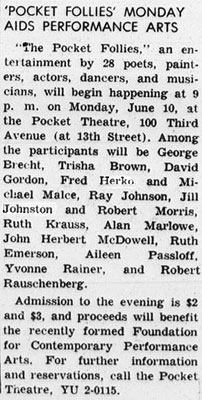
Village Voice (June 6, 1963), p. 7
Organized by JAMES WARING, The Pocket Follies was a benefit for the Foundation for the Contemporary Performance Arts. John Cage and Jasper Johns were both on the board of the Foundation which raised money through the sale of art to finance performances by Merce Cunningham and the Judson Dance Theater.
The evening featured collaborations by FRED HERKO and Michael Malcé and by JILL JOHNSTON and Robert Morris; and dance/performances by RAY JOHNSON, George Brecht, Trisha Brown, David Gordon with Valda Setterfield, Allen Marlowe, John Herbert McDowell, Aileen Passloff and Yvonne Rainer. Plays included Ruth Krauss' A Beautiful Day directed by Remy Charlip and N.F. Simpson's Oh; A Compendium of Everyone's Remarks, Act II directed by JAMES WARING. (JD132)
JUNE 23 - JUNE 25, 1963: BILLY NAME DOES LIGHTS FOR JUDSON DANCE THEATER INCLUDING PERFORMANCES BY FREDDY HERKO AND LUCINDA CHILDS AND A DANCE TITLED BINGHAMTON BIRDIE.
BILLY NAME (Linich) did lights for Concerts #6, 7 and 8 at the Judson Memorial Church. The performances took place in the sanctuary rather than the gymnasium of the church. Herko's dance, Binghamton Birdie was presented as part of Concert #6. BINGHAMTON BIRDIE was, like Herko, a speed freak who sometimes hung out at the Factory. Warhol filmed two SCREEN TESTS of him and Birdie also appeared in COUCH.
See "Judson Dance Theater Concerts #6, 7 and 8."
JUNE 1963: ANDY WARHOL BUYS A MOVIE CAMERA. (AD290)
Gerard Malanga and Charles Henri Ford went with Warhol to Peerless Camera where he bought "a 16mm Bolex with thru-the-lens focusing complete with motordrive that allowed for a one-shot three-minute take." (GMW37/106).
According to Popism, the first movie he made with his new Bolex was SLEEP, starring JOHN GIORNO, an ex-stockbroker who had “dropped out” to become a poet (later starting the telephone service Dial-A-Poem in the late sixties). (POP33)
JULY 1963: ANDY WARHOL SHOOTS SLEEP.
SLEEP was not continuous footage of a man (JOHN GIORNO) sleeping. It was noticeably edited in a repetitive manner. Sarah Dalton was the editor of the film and drawings she made on the film boxes indicate that although Warhol would become known for just turning the camera on and letting it record whatever was happening, this was not the case with SLEEP, even though reviewers tended to characterize it as continuous footage of a man sleeping.
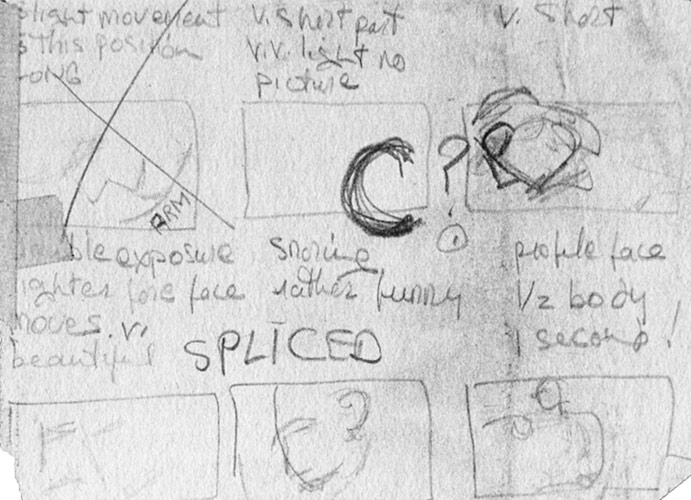
Sarah Dalton's notes on a Sleep film box, 1963 (Andy Warhol Foundation for the Visual Arts, Inc.
Although the repetitive structure of SLEEP has been compared to Eric Satie's Vexations, there is no evidence that Warhol's editing of the film was inspired by Vexations. A quote by HENRY GELDZAHLER comparing SLEEP to a Vexations concert that had taken place earlier in the year was used to advertise SLEEP, but GELDZAHLER did not claim that Warhol's editing of SLEEP had anything to do with the concert. Warhol may have been trying to capitalize on the publicity that the Vexations concert had generated. He claimed to have sat through the whole concert which lasted 18 hours and 40 minutes, but he is not mentioned in the press coverage of it. (The New York Times coverage of the Vexations concert is here.)
See also:
Notes on John Cage, Erik Satie's Vexations and Andy Warhol's Sleep
JUNE - JULY 1963: ANDY WARHOL PAINTS THE KISS (BELA LUGOSI). (RN354)
Warhol would also begin shooting his film Kiss during the same summer - see c. August 1963 below.
LATE JULY 1963: TED BERRIGAN MEETS ANDY WARHOL.
Poet Ted Berrigan met Warhol at a poetry reading given by Frank O'Hara. Shortly thereafter, Warhol designed the front and back cover of the September issue of Berrigan's poetry magazine, C: A Journal of Poetry. The title of the magazine is reminiscent of the title of Warhol's later book - A: A Novel. The September issue of C was devoted to the poetry of Edwin Denby. The photograph that Warhol produced for the front cover of the magazine showed Gerard Malanga standing behind a seated Denby who was holding Malanga's hands on his shoulders. The back cover photograph showed Malanga kissing Denby. (RW20/21)
According to Gerard Malanga, Warhol filmed O'Hara at the Cafe Le Metro in Spring 1964 but the film was never screened and "disappeared into Andy's apartment..." (RW21, 160 fn 26)
Warhol filmed a Screen Test of Berrigan on March 3, 1965. (AD37) Warhol filmed Denby's Screen Test "probably" in early 1964. In 1965 Denby wrote dialogue for a movie that Warhol planned to make - Messy Lives. Denby's contribution was later published and performed as a play - Four Plays by Edwin Denby - at the Eye and Ear Theatre. Warhol's film was never made. (AD62)
JULY 30 AND AUGUST 1,6, AND 8, 1963: FREDDY HERKO PERFORMS WITH JUDSON DANCE THEATER - BILLY NAME DOES LIGHTS/PROGRAMMING (CONCERT NOS. 9, 10, 11 and 12).
In addition to Herko dancing and Billy Linich (aka BILLY NAME) doing the lights (along with JOHNNY DODD) and being involved in the programming, BIBBE HANSEN'S father, the Fluxus artist Al Hansen did the sets and served as stage manager. Hansen and mail artist RAY JOHNSON (who later assisted Warhol in filming Jill Johnston Dancing) danced in a piece called Animals.
The dance performances (twenty five pieces) took place at the Gramercy Arts Theater instead of the Judson Church. The theater was also showing films on the nights not taken up by the dance troupe. On August 5th, the night before Concert #11, JACK SMITH'S Flaming Creatures was shown.
See "Judson Dance Theater Concerts 9 - 12."
SUMMER 1963: TAYLOR MEAD MEETS ANDY WARHOL.
According to Andy Warhol Screen Tests: The Films of Andy Warhol Catalogue Raisonné, Vol. 1, "Taylor Mead met Warhol in the summer of 1963, when Henry Geldzahler took him along on a visit to Warhol's home on Lexington Avenue." (AD126)
1963: HOLLY WOODLAWN MEETS CANDY DARLING.
One evening, Holly Woodlawn was hanging out with her friend Libra outside an ice cream parlour on the corner of Eighth Street and Sixth Avenue. Candy Darling was eating an ice cream cone when a hustler asked her for a cigarette. When she refused and then told the hustler to move because he was blocking her light, the hustler shoved the cone into Candy’s face. She stammered “in that affected Kim Novak whisper, ‘Well, I never ... how could you?’” Holly started talking to her, they became friends and Holly started going over to her house on Long Island where Candy lived with her mother. (HW69)
Candy’s mother was “an obsessed movie fan” who idolized Joan Crawford and often wrote her fan mail. One room of their house had been turned into a library filled with stacks of fashion magazines. (HW67) Candy wasn't yet living as a woman - just “a very pretty boy in makeup hiding behind dark sunglasses, his face peeking out of an upturned trench coat collar.” (HW69)
Candy had experimented with several names - Hope Dahl, Candy Dahl and finally Candy Cane until she met a transvestite name Taff Tits Terrifik who called her darling so much that Candy adopted it as her last name. (HW68)
c. AUGUST 1963: ANDY WARHOL SHOOTS KISS.
Some Warhol scholars date the Kiss films from November/December 1963. However, Warhol probably started shooting them much earlier - around August 1963 and continued to shoot them through the end of 1964, if not beyond. (SG144/CA) According to Warhol in Popism, they were still doing KISS movies in the summer of 1964 when Gerard Malanga and Mark Lancaster did one - in August 1964. (POP71/M) Malanga and Lancaster were not the only male/male couple in Kiss.
Callie Angell:
... there is a Freddy Herko/Johnny Dodd Kiss film, but it's not in the preserved version that MoMA distributes. (There are quite a few Kiss rolls not in that MoMA version, by the way -- they were found in their individual 100-ft. boxes). The first Kiss films (mostly with Naomi Levine) were shot prob. in August of 1963, but the series continued to be shot through at the least the end of 1964.
But there are other male-to-male Kisses in the MoMA version of Kiss, aren't there... Andrew Meyer and John Palmer (on the couch in front of the Jackie paintings), and also Steve Holden and somebody..." (email 10 July 2003)
According to Bob Colacello, the idea for KISS - close-ups of couples kissing each other for three minutes each - came from the old Hayes Office regulation forbidding actors in movies from touching lips for more than three seconds. (BC29)
The 1929 film The KIss, starring Greta Garbo, had also been screened at the final screening of Cinema 16 in May 1963 (see above) although it's not known whether Warhol's Kiss films had anything to do with the Garbo film. Given his interest in Garbo, it's likely that Warhol was at least aware of the film.
Warhol also produced a silkscreen called The Kiss, based on a film still from the Hollywood horror classic Dracula (1931) of Bela Lugosi biting the neck of his co-star, Helen Chandler. The silkscreen was done on November 22, 1963. (GMW81)
Amy Taubin, who would later become the film critic for the Village Voice, first saw some of the KISS films in 1963 at the Grammercy Arts Theater on West 27th Street. At this time the KISS series of films was called The Andy Warhol Serial "because it was shown in weekly four minute installments." (WI24)
(To filmography)
AUGUST 25/26, 1963: BILLY NAME DOES LIGHTING FOR JAMES WARING'S DANCE COMPANY AT THE JUDSON CHURCH.
Although the concert was billed as a presentation of the Judson Dance Theater, Waring was not a member of the Dance Theater in so far as he did not attend their weekly workshops. Many of the dancers in his group, however, did attend the workshops, including LUCINDA CHILDS, Deborah Hay, FRED HERKO, Yvonne Rainer, and Arlene Rothlein.
Dance pieces performed on August 25th and 26th by Waring's company included Poet's Vaudeville (featuring music by John Herbert McDowell and words by Diane di Prima) and Phrases (for which McDowell played the piano - originally choreographed in 1956 to music by Erik Satie).
Billy Linich (aka BILLY NAME) designed the lighting for the concert. (JD165)
AUTUMN 1963: ANDY WARHOL GOES TO POETRY READINGS.
In addition to attending underground film screenings, Warhol went to poetry readings with GERARD MALANGA - including Monday nights organized by PAUL BLACKBURN at the Cafe Le Metro on Second Avenue between 9th and 10th Street where each poet would read for five or ten minutes. (POP51)
SEPTEMBER 9, 1963: TAYLOR MEAD PARTICIPATES IN "JAIL POETS" AT THE LIVING THEATRE.
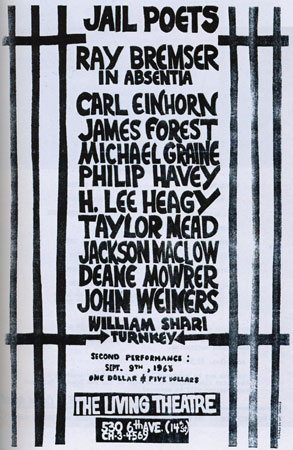
SEPTEMBER 1963: ANDY WARHOL MEETS JOHN ASHBERY.
The poet and sometimes art critic, John Ashbery, met Warhol and Gerard Malanga while Ashbery was on a trip to New York where he gave a poetry reading at the Living Theatre. Malanga attended the poetry reading. Frank O'Hara gave a party for Ashbery during his stay in New York and it was "probably" at this party that Ashbery actually met Malanga who took him to Warhol's studio. (RW86) Warhol shot a SCREEN TEST of Ashbery in 1966 when he was working as executive editor of Art News magazine. Ashbery found his Factory experience "intimidating," because "there were all these people doing their strange tasks." (AD33)
SEPTEMBER 19, 1963: FIRST PERFORMANCE OF ASPHODEL, IN HELL'S DESPITE AT THE JUDSON MEMORIAL CHURCH.
The play was a production of the Judson Poets Theater with a stage design by Andy Warhol and directed by JERRY BENJAMIN who also co-directed Warhol's film, SOAP OPERA.
See Asphodel at the Judson Poets Theater.
SEPTEMBER 30 - OCTOBER 1963: ANDY WARHOL HAS A SECOND SHOW AT THE FERUS.
Warhol's second show at the Ferus Gallery in Los Angeles included his ELVIS paintings. (L&D502/PS221) Warhol's film footage, Elvis at Ferus, was shot during this show.
Irving Blum:
"Andy sent a roll of printed Presley images, an enormous roll, and sent a box of assorted size stretched bars... I said, 'You mean, you want me to cut them? Virtually as I think they should be cut and placed around the wall?' And he said, 'Yes, cut them any way that you think should... The only thing I really want is that they should be hung edge to edge, densely - around the gallery...' And that's exactly what I did... Sometimes the images were superimposed one over the next. Sometimes they sat side-by-side. They were of varying sizes... All the same height - roughly six-and-a-half feet, as I recall. Really, life size... And I got up as many stretched up as required to fill - densely - the gallery, as per Andy's instructions. And I sent what was left on the roll back to Andy and opened the exhibit." (PS222)
SEPTEMBER 24, 1963: ANDY WARHOL AND ENTOURAGE LEAVES FOR LOS ANGELES WHERE HE SHOOTS TARZAN AND JANE REGAINED, SORT OF....
Warhol and his entourage (including Wynn Chamberlain, Taylor Mead and Gerard Malanga) drove to L.A. for the opening of his second exhibition at the Ferus Gallery. They left on September 24, 1963 and the trip took four days. (DDA3)
As Andy and Gerard did not know how to drive, Taylor and Wynn shared the driving. Although Andy had been around the world once in the fifties, he’d never been west of Pennsylvania in the U.S. (POP35)
While in Los Angeles, they were joined by Warhol's first superstar Naomi Levine and shot scenes for TARZAN AND JANE REGAINED, SORT OF... including around the bathtub of their suite at the Beverly Hills Hotel. (POP43)
to filmography
OCTOBER 1963: BILLY NAME EDITS THE FLOATING BEAR.
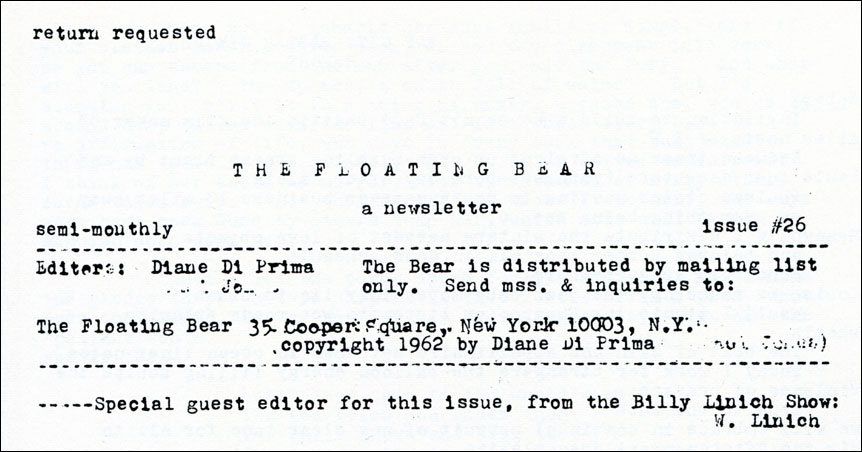
Masthead of issue #26 of The Floating Bear with "W. Linich" (Billy Name) as guest editor
Billy Name (under his real name Billy Linich) guest edited issue no. 26 of The Floating Bear, a newsletter originally conceived as a publication by writers for writers by its founders Diane di Prima and LeRoi Jones. The first issue was published in February 1961. Jones resigned after issue no. 25 (November 1962 - March 1963) (FB)
Diane de Prima (from taped interviews July 29-August 1, 1970):
After LeRoi left the Bear was starting to get one-sided, so I asked various people to guest-edit some of the issues. Number 26 was guest-edited by Billy Linich. Billy was working for us for free, whenever he felt like it: helping with the mail and the Bear mailing list and all that, and I let him guest-edit an issue, which turned out to be very like The Sinking Bear [a parody of The Floating Bear] ed. by Soren Angenoux with various collaborators including Ray Johnson, Billy Linich (Name) and Bibbe Hansen's father, Al Hansen]. Lots of letters and puns and in-group jokes... Billy also typed Numbers 27, 28, and 29, and did a lot of work for the New York Poets Theatre. In Number 29 there was a piece by John McDowell, and John had made just about every sentence into a separate paragraph, and Billy when he typed the issue made the whole thing into a lot fewer paragraphs, which made John not too happy. Billy by that time was also putting comas into people's poems, and things like that, but that particular piece made a controversy between Billy and me which made Billy go way. That was unfortunate, both because I like Billy very much, and because it slowed us down even more than ever.
The Billy moved in with Andy Warhol, and changed his name to Billy Name, and lined the walls of Andy's studio with tinfoil which made Andy very famous. He worked for Andy for free for six or seven years. I saw him in San Francisco recently, and he was living on the street and had changed his name to Kingdom Unknown Name. (FBxvii)
NOVEMBER 1963: THE FLOATING BEAR ANNOUNCES STABLE MAGAZINE DESIGNED BY ANDY WARHOL.
The November Issue (no. 27) of The Floating Bear, an underground newsletter published by Diane di Prima and LeRoi Jones, contained the following announcement:
STABLE - a literary-arts magazine. 1st issue Feb. 1. New work by Berrigan, Di Prima, Ceravolo, Shapiro, Malanga, Ashbery, Agenoux, Brodey, et al. designed by Andy Warhol; edited by Gerard Malanga. $1.00. Mss. & orders to Gerard Malanga, c/o Andy Warhol, 1342 Lexington Ave., NYC (published by Eleanor Ward of Stable Art Gallery) (FB328)
NOVEMBER 1963: ANDY WARHOL FILMS BILLY NAME CUTTING HAIR.
See: Haircut
In addition Warhol's film, a review of one of Billy Name's (Billy Linich's) haircutting parties appeared in the November 1963 issue of The Floating Bear.
The Floating Bear newsletter, issue #27, November 1963, Diane di Prima (ed.).
For full article click here
DECEMBER 22/23 1963: ROBERT RAUSCHENBERG DOES LIGHTS FOR MOTORCYCLE AT THE JUDSON CHURCH.
Motorcycle was both the name of the evening - which consisted of new and old dances presented by Judith Dunn - and the name of the first dance on the program. Robert Rauschenberg designed the lighting. (JD182)
LATE 1963 - EARLY 1964: ANDY WARHOL DOES FIRST SELF-PORTRAITS AND JUDITH GREEN PORTRAIT.
From the Andy Warhol Catalogue Raisonné (Vol. 1):
"Warhol's first self-portrait was commissioned by the collector Florence Barron in late 1963; three years later, Mrs. Barron commissioned her own portrait. The photobooth strip that Warhol used for his self-portrait was pasted side by side with a photobooth strip of Judith Green. As with the Ethel Scull portrait, the eight images were enlarged onto a single screen, individually masked and printed. Warhol's mechanical also includes specifications for a Mott's box sculpture at the lower left. Based on an invoice from the silkscreen maker for the sculptures, dated to early January, both portraits may be dated to late 1963 - early 1964." (RN426)
DECEMBER 1963 - FEBRUARY 1964: ANDY WARHOL DOES LATE DISASTER PAINTINGS.
From the Andy Warhol Catalogue Raisonné (Vol. 1):
"Not long after he had discussed the origins of the disaster paintings with Gene Swenson, Warhol embarked on the final subjects of this series... referred to here as the 'late disasters.' Although these works are structured as serial compositions (cat. no. 545, as a single impression, is an exception), as the earlier 'disasters' were, the later paintings have been have been made from much larger screens, so that the image is repeated fewer times... Each image is made up of two screens measuring 40 x 60 inches each in Saturday Disaster and the Ambulance Disasters, and 40 by 50 inches each in Foot and Tire. The larger screen size corresponds to a December 2, 1963, silkscreen maker's invoice, now in the Warhol archive, for four halftone enlargements of 'auto accident scenes.' If the screens were not fabricated until December, it is possible that the paintings were made in early 1964. During most of January, Warhol was looking for a new studio, which he found at the end of the month. It seems unlikely, therefore, that he made many works that month. In March, Warhol was visited by Ellen Johnson, who later sent him a photograph made from a slide she took at the new studio. In it, Saturday Disaster can be seen in the foreground, unstretched on the floor... Based on this documentation, the 'late disasters' can be dated to the period between December 1963 and February 1964." (RN459)

